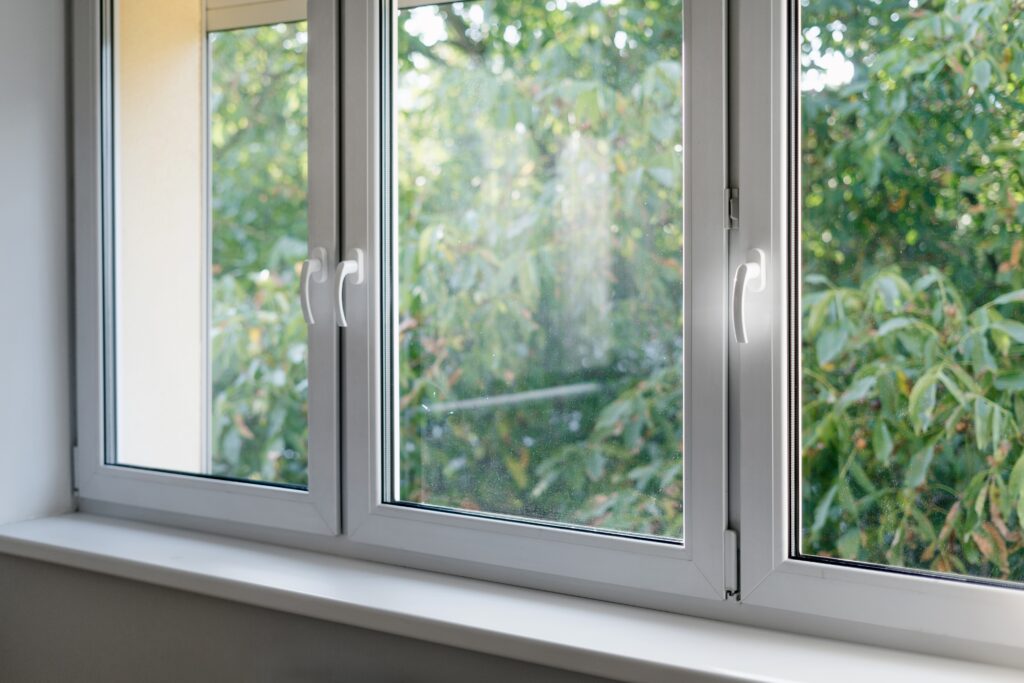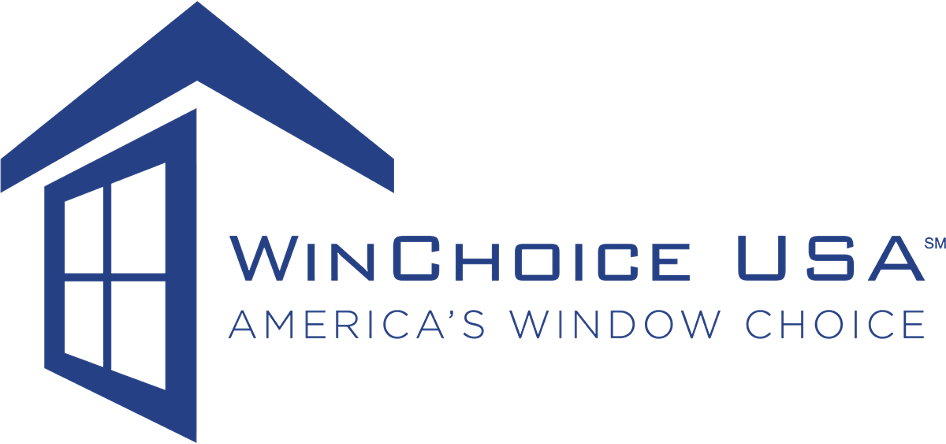Types of Window Frame Materials

Windows do more than let in light—they help regulate temperature, reduce energy bills, and add character to your home. While glass gets most of the attention, it’s the frame that often determines how well a window performs over time.
In this guide, we’ll compare the five most common window frame materials—vinyl, wood, aluminum, fiberglass, and composite. You’ll learn how each one measures up in terms of cost, maintenance, energy efficiency, and long-term value so you can choose what works best for your home and your budget.
Table of Contents
- Common Types of Window Frame Materials
- Factors to Consider When Choosing a Window Frame Material
- Best Window Frame Material for Different Needs
- Best Window Frame Material for Budget Buyers
- Best Window Frame Material for Energy Efficiency
- Best Window Frame Material for Aesthetic Appeal
- Best Window Frame Material for Durability
- Best Window Frame Material for Low Maintenance
Common Types of Window Frame Materials
Different window frame materials come with unique characteristics in terms of cost, strength, insulation, style compatibility, and upkeep. Understanding these differences can help you find a solution that aligns with your budget, aesthetic preferences, climate needs, and lifestyle.
Vinyl Window Frames
Vinyl window frames are made from polyvinyl chloride (PVC), a type of plastic known for its affordability and durability. They’ve become one of the most popular choices in the U.S., particularly for homeowners looking to replace windows on a budget.
Pros:
- Affordable: One of the most cost-effective window materials.
- Energy-efficient: Naturally good insulation helps reduce heating and cooling bills.
- Low maintenance: No need to paint or seal; won’t rot or rust.
- Moisture and pest resistant: Ideal for humid or pest-prone environments.
Cons:
- Limited color choices: Paint doesn’t adhere well, so color options are limited.
- Less durable than others: Not as long-lasting as fiberglass or well-maintained wood.
- Cannot be repaired easily: If damaged, frames often need full replacement.
Best for: Budget-conscious homeowners who want reliable, low-maintenance, and energy-efficient windows.
Wood Window Frames
Wood is the traditional window frame material, appreciated for its natural appearance and insulating power. It works well in both historic homes and upscale modern properties.
Pros:
- Classic aesthetic: Natural grain and color add visual warmth and charm.
- Highly customizable: Can be painted or stained to match any décor.
- Excellent insulation: Wood is a poor conductor of heat, helping maintain indoor temperatures.
Cons:
- High maintenance: Requires regular painting or sealing to protect against moisture.
- Susceptible to rot and pests: Without care, wood can warp, rot, or be infested.
- More expensive: Higher upfront and long-term maintenance costs.
Best for: Homeowners seeking a high-end or traditional look and willing to commit to ongoing upkeep.
Aluminum Window Frames
Aluminum window frames are sleek, durable, and often used in modern or industrial-style homes. They offer a minimalist aesthetic with thin profiles that maximize glass area.
Pros:
- Strong and lightweight: Ideal for large window spans.
- Weather-resistant: Doesn’t warp or crack over time.
- Low maintenance: No need for painting or sealing.
Cons:
- Low energy efficiency: Aluminum conducts heat and cold, which can drive up energy costs.
- Condensation issues: Frames can “sweat,” leading to potential mold growth if not well managed.
- Can corrode in salty air: Not ideal for coastal homes unless specially treated.
Best for: Contemporary homes in mild climates where style and durability matter more than insulation.
Fiberglass Window Frames
Fiberglass is a top-tier material in terms of performance and longevity. It’s made from glass fibers and resin, offering strength comparable to aluminum but with better energy efficiency.
Pros:
- Extremely durable: Doesn’t warp, crack, or corrode over time.
- Low maintenance: Holds paint well and resists decay.
- Great insulation: Similar thermal properties to wood and vinyl.
- Eco-friendly: Often made from recycled materials.
Cons:
- Higher cost: More expensive than vinyl and aluminum.
- Limited availability: Not offered by every window manufacturer.
- Fewer aesthetic options: Fewer styles and finishes compared to wood.
Best for: Homeowners wanting a long-lasting, energy-efficient frame and willing to pay more upfront.
Composite Window Frames
Composite frames are typically made from a mix of wood fibers and synthetic resins or polymers. They combine the best of wood and vinyl for a durable, stable product.
Pros:
- Wood-like look without the upkeep: Mimics wood grain but resists rot and insects.
- Stable in all climates: Won’t expand or contract much with temperature changes.
- Good energy efficiency: Similar to wood and fiberglass.
- Low maintenance: No regular painting or sealing required.
Cons:
- More costly than vinyl: Not ideal for budget projects.
- Less common: Fewer manufacturers offer them, limiting design flexibility.
Best for: Homeowners who want the look of wood with less hassle, and are open to spending more for performance and style.
Factors to Consider When Choosing a Window Frame Material
Beyond looks and price, choosing the right window frame involves thinking about your local climate, energy goals, and how much maintenance you’re willing to take on. Here’s what to weigh.
Climate
Your local weather should influence the window frame material you choose. Moisture, heat, and temperature swings all affect how different materials perform over time.
- Hot/humid climates: Vinyl and composite resist moisture and heat.
- Cold climates: Wood and fiberglass provide superior insulation.
- Coastal homes: Aluminum (with protective coatings) and fiberglass handle salt and humidity better.
Energy Efficiency
Energy-efficient frames help your HVAC system work less, saving you money year-round. Understanding thermal performance is key when comparing materials.
- Top performers: Fiberglass, composite, and vinyl
- Lower performers: Aluminum (unless it has a thermal break)
Pro tip: Look for ENERGY STAR–rated products and check the U-factor (lower = better insulation) and SHGC (Solar Heat Gain Coefficient).
Maintenance Needs
Some window frames need regular attention; others are virtually hands-off. Choosing based on how much upkeep you’re willing to do can save you time and money later.
- Low maintenance: Vinyl, aluminum, fiberglass
- Medium: Composite
- High: Wood
Cost & Budget
The upfront cost of window frames varies widely, but so does the lifespan and maintenance burden. Frame cost varies by material, brand, and window size:
Material | Price Per Window | Maintenance | Lifespan |
Vinyl | $200 – $800 | Low | 20 – 40 years |
Wood | $300 – $1,200 | High | 30+ years |
Aluminum | $250 – $1,000 | Low | 20 – 30 years |
Fiberglass | $500 – $1,500 | Low | 30 – 50 years |
Composite | $400 – $1,200 | Low–Medium | 30+ years |
Installation costs are typically $100–$300 per window but vary based on location and complexity.
Aesthetics & Home Style
Window frames should complement your home’s architecture and overall look. Some materials offer more style flexibility than others.
- Traditional: Wood or wood-look composites
- Modern/Contemporary: Aluminum or fiberglass
- Transitional: Vinyl in neutral tones or painted fiberglass
Best Window Frame Material for Different Needs
Still not sure which material makes the most sense for your home? It’s common to feel overwhelmed with all the options, especially when cost, energy savings, and style all matter in different ways. That’s why it helps to match the material to your top priority. Below are the most common homeowner concerns and which window frame materials tend to meet them best.
Best Window Frame Material for Budget Buyers
If your goal is to keep costs manageable without sacrificing too much in performance, vinyl window frames are the best place to start. They’re widely available, simple to install, and among the most affordable options on the market.
Vinyl offers solid energy efficiency and requires very little upkeep, making it an excellent choice for homeowners trying to get the most value from their investment. While it may not deliver the same visual appeal as wood or the strength of fiberglass, vinyl is more than capable of meeting everyday needs on a budget.
Best Window Frame Material for Energy Efficiency
When energy efficiency is a top concern, fiberglass and composite frames stand out. These materials are better insulators than aluminum and are more stable across temperature changes than wood or vinyl. Fiberglass, in particular, resists expansion and contraction, which helps maintain a tight seal and reduces heat transfer.
Composite frames also perform well thanks to their blended construction of wood fibers and polymers, which makes them strong and energy-conscious. Although they come with a higher price tag, the long-term energy savings can make them well worth it.
Best Window Frame Material for Aesthetic Appeal
For homeowners focused on aesthetics and authenticity, wood remains the preferred choice. Real wood frames provide warmth, texture, and character that synthetic materials can only imitate. Whether you prefer a painted finish or natural wood grain, the look of wood complements traditional architecture and adds an upscale feel to almost any home.
This material is especially appealing in historic renovations or high-end custom builds. Keep in mind that this visual appeal comes with a maintenance commitment, but for many, the charm is worth the effort.
Best Window Frame Material for Durability
If long-term durability is your main concern, both fiberglass and aluminum are excellent contenders. Fiberglass is known for its strength and resistance to warping, cracking, and weather damage. It performs well in a variety of climates and holds its shape even after years of temperature shifts.
Aluminum, while not as energy-efficient, offers high structural integrity and is often used in commercial or modern home designs. It stands up to harsh sun and wind without breaking down, making it a good fit for areas that see a lot of environmental wear and tear.
Best Window Frame Material for Low Maintenance
For homeowners who want windows that require as little attention as possible, vinyl and aluminum are the top choices. Vinyl frames don’t need to be painted or sealed, and they resist fading, rot, and insect damage. They’re perfect for busy households or rental properties where simplicity matters.
Aluminum also earns high marks for being virtually maintenance-free. It won’t rust or warp and holds up well in dry climates. If avoiding regular upkeep is important to you, either of these materials will keep your windows looking good with minimal effort.
Conclusion
Choosing the right window frame material requires weighing several factors—climate, cost, maintenance, and home style. Here’s a quick recap:
- Vinyl: Great for budget-conscious buyers who want low maintenance and solid energy performance.
- Wood: Offers unmatched character and insulation but requires ongoing maintenance.
- Aluminum: Sleek and durable, ideal for modern homes in milder climates.
- Fiberglass: Durable and energy-efficient, but with a higher upfront cost.
- Composite: Blends the best features of wood and vinyl for a premium, low-maintenance option.
Before deciding, consider your long-term needs and consult with a local window professional. A contractor can assess your home’s specific requirements, show you samples, and ensure proper installation.
Additional Window Resources
- Benefits of Clerestory Windows
- Are Pop-In Windows Energy Efficient?
- How to Prepare Your Home for a Seamless Window Installation

Anna has over six years of experience in the home services and journalism industries and serves as the Content Manager at MyHomePros.com, specializing in making complex home improvement topics like HVAC, roofing, and plumbing accessible to all. With a bachelor’s degree in journalism from Auburn University, she excels in crafting localized, comprehensive guides that cater to homeowners’ unique needs. Living on both coasts of the United States has equipped her with a distinctive perspective, fueling her passion for turning any house into a cherished home through informed, personalized decision-making.
Connect with top-rated local contractors who can help you with siding, roofing, HVAC, windows, and more. Get free quotes from verified professionals in your area today.








